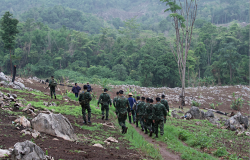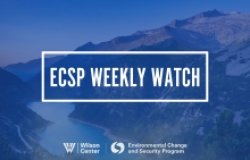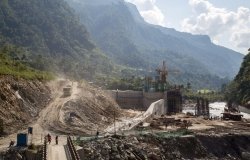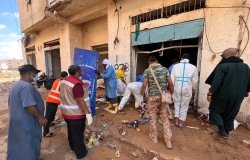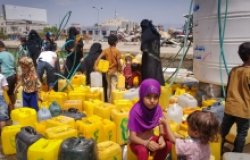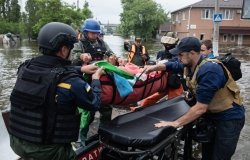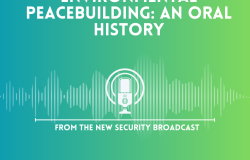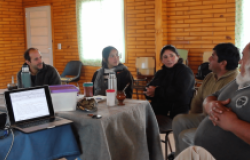The President's Emergency Plan for AIDS Relief: Stepping Up to the Global Challenge
In this recent speech, U.S. Global AIDS Coordinator Randall Tobias delineated President Bush's AIDS Plan, focusing on prevention, treatment, and stigma reduction. The ambassador conveyed both the devastation and hope he witnessed on a recent trip to Africa. His full remarks are available here.
Thank you to my friend, Congressman Hamilton. It’s a great pleasure to be here. Your service to your country and the world is an example to all of us, and as a fellow Hoosier I am especially privileged to join you here today. Thanks to all of you for being here this morning, many of you representing organizations making contributions to the battle against HIV/AIDS, as advocates, as service providers, and as policy makers. Many of you were among the first responders to this crisis, assisting people and communities devastated by HIV/AIDS, and generating international momentum against the disease.
I have just returned from a trip to Africa – my second since being confirmed sixty days ago. Again, I was struck in every country we visited — this time Zambia, Rwanda, Kenya, and Uganda — by the amazing work being carried out in partnerships among communities, non-governmental organizations, governments, and donors. Regardless of barriers imposed by stigma, silence, lack of leadership, or very limited resources, I saw yet again the results that can be achieved in the battle against HIV/AIDS, and the new possibilities for intervention that have been illuminated.
I stand before you today as the first United States Global AIDS Coordinator, with the awesome responsibility – and the extreme privilege – of leading a five-year, $15 billion effort to combat global AIDS. The President’s plan represents the largest commitment ever by a single nation for an international health initiative. There’s been nothing like it for any humanitarian purpose, perhaps since the Marshall Plan. In part, President Bush’s decision to launch this initiative is a testament to the work of many of the organizations represented here this morning. You brought voice to the devastation of this pandemic, you helped develop strategies to combat the disease, you provided armies of women and men serving people and communities in need.
I know that many of you are very familiar with the statistics on the global devastation of HIV/AIDS. They bear repeating as an affirmation of our commitment, and in recognition of the people who suffer the greatest burdens of this disease. During 2002 alone, 3 million people died from the complications of AIDS, leaving behind anguished loved ones, abandoned children, ravaged communities. At the same time, 5 million people became newly infected.
Do the math. We are losing the war. At the current pace, we’re headed for the destruction of the world – with a great deal of human tragedy and political and social destabilization along the way. 40 million people are infected worldwide. And tragically, very tragically, most do not know they are infected. Far too few people are being tested, and I think that is one of the initial things that must be addressed, and must be changed.
This is a disease that is 100% preventable, so Prevention is the chief weapon in the spread of HIV, and it must be our number one priority. And testing – knowing one’s status and what to do about it – is one of the keys to prevention. When this epidemic was first addressed in the United States, discovering one’s status was thought to be the beginning of living with stigma – and a certain sentence of death. With the availability of antiretroviral drugs, it is now possible for someone living with HIV/AIDS to live a normal, productive life, and to eventually die of something else. That’s what is possible. To make it a reality will require an almost unimaginable effort, and that’s what we are now all about. Stigma, however, is still a huge issue – an enormous barrier to testing. We must find new more effective ways to make it both acceptable and desirable for people to want to know their status.
In claiming the lives of societies’ most productive populations – adults ages 15-45 – HIV/AIDS threatens a basic principle of development – that each generation do better than the one before. This disease has deepened poverty, reduced life expectancy, diverted state resources and left a generation to grow up without the love, guidance and support of parents and teachers. This year, however, may bring the hope of a new approach. The global community is coming into alignment to focus on HIV/AIDS as never before, with every sector — public, private, religious, non-governmental, multilateral — making contributions to the fight. Increasingly, national leaders are admitting that they do in fact have an HIV problem in their countries, and will in fact devote more resources to fighting it. Lessons have emerged and leaders are beginning to take heed: We now have proven methodologies for combating HIV/AIDS, including effective prevention and behavior-change strategies that have produced real results; approaches to fighting stigma and discrimination; and proven programs that partner government with civil society.
We know that global and national leadership is essential, that early and effective action can contain and even roll back epidemics and reduce the burdens of disease on families, communities, and nations. But we’re also mindful that the statement by the late Tip O’Neal that “all politics is local” applies equally to public health. The battle against HIV/AIDS will, in the end, be won or lost in the small places – places so small you may not find them on any map of the world. I was in one such place last week, a tiny farm settlement in Uganda just outside a small town called Tororo. There, the Centers for Disease Control of the Department of Health and Human Services is partnering with TASO, a community based support organization for persons living with AIDS, providing patients with safe water, an antibiotic to prevent opportunistic infections, and – importantly – antiretroviral drug therapy. While I was there, I visited two of those patients and their families, in their homes – mud structures with straw roofs and dirt floors. Community health workers who are part of this program visit each patient weekly, on small motorcycles, to monitor their condition, their adherence to the therapy regimen, and to deliver their supply of medication. Their progress since beginning treatment is amazing. And their adherence to the therapy regimen is nearly 95% – much higher than our experience in the United States. And what’s even more reassuring is the ability of these community health workers to impart complicated information that is fully comprehended.
Let me give you an example. One of the patients I visited – a man named John – is HIV positive and on the antiretroviral therapy program. His wife – also HIV positive – is not. When I asked him, through the translator, if there was any conflict in the family, any temptation because he had access to this life saving medicine and his wife did not – was there any temptation to share the medication? He told me it was not an issue because his CD4 cell count was 162 and he needed the medicine now, but his wife’s CD4 cell count was 312, and she didn’t. He said they understood that when her count dropped below 200, she too would be put on the program. Understanding can be conveyed and ARV therapy can be effectively administered in very primitive places.
Where there used to be a “treatment versus prevention” debate, today few dispute that these are not “either/or” issues. Clearly, prevention must be our number one priority in order to stop the spread of the disease. That has been the approach in Uganda, and it works. I’ve visited their primary schools to see how they do it. It is straight forward, relatively inexpensive, and enormously effective. The message has three components:
1. Be abstinent until marriage.
2. Don’t associate with people who will harm you or will try to convince you to do the wrong things.
3. Be a strong person and stick to what you know will keep you safe and healthy.
But prevention is not the only answer. Where a life can be saved, it must be saved. That’s why treatment is also an imperative. And the implementation of life saving antiretroviral treatment also provides the incentive for people to be tested and to learn their HIV status. That, in turn, contributes to prevention efforts. There are no bright lines between prevention, treatment, and care. They all contribute, and are interconnected, in achieving results against HIV/AIDS.
The United States has stepped up to the challenge of global HIV/AIDS with President Bush’s Emergency Plan for AIDS Relief. As President Bush has stated, “in the face of preventable death and suffering, we have a moral duty to act, and we are acting.” The President’s five-year initiative is targeted to providing treatment medicines to at least 2 million HIV-positive individuals, preventing 7 million new HIV infections, and caring for 10 million people living with HIV/AIDS and orphans and other vulnerable children directly impacted by the disease. The Plan offers $9 billion in funding to 14 target countries in Africa and the Caribbean, representing 50 percent of the world’s population of people living with HIV/AIDS. I have visited in the last 60 days eight of those countries, and have seen firsthand the need to rapidly scale up the HIV/AIDS response. The Plan also includes $1 billion in contributions to the Global Fund, bringing total U.S. contributions to $1.6 billion — more than one third of all pledges to the fund to date. And it provides $5 billion to continue our bilateral assistance to nearly 60 other countries worldwide. This is to say that President Bush did not make me the “14-country AIDS Coordinator,” he made me the Global AIDS Coordinator, with a particular focus on turning the tide in the most highly impacted countries of the world.
The plan begins in fiscal year 2004 with well over $2 billion in funding, steadily increasing to reach the total of $15 billion over the five years. We know that we are embarking on an effort unrepresented by any other nation, with the mission of turning the tide against HIV/AIDS. We will work with target countries to develop necessary infrastructure, and the technical and absorptive capacity, to use these funds effectively and efficiently in achieving results against HIV/AIDS, and will ramp up our funding accordingly. We cannot, and will not, fail in the fight against HIV/AIDS.
The House passed our appropriations bill Monday, but the Senate has yet to act. The money for this program is embroiled in the omnibus appropriations bill, and as of the moment, it appears unlikely we will have any funding before mid to late January. But we have no time to waste. This is a fight in which 8,500 people lose their lives daily--the equivalent of 20 fully-loaded Boeing 747s crashing each day. Imagine waking up in the morning and reading in the paper that 20 planes had crashed, killing all aboard. Then imagine getting up the next morning and reading the same thing—and the next, and the morning after that. That is the toll wrought by AIDS.
Although my office is in its very formative stages, we have been able to move forward with development of a strategy and guiding principles such that we can take prompt action against this disease, once we receive funding from the Congress. A fundamental principle of the overall plan is to develop sustainable prevention, care, and treatment programs for HIV/AIDS. As we do that, we need to keep in mind that Albert Einstein once said that stupidity is doing the same thing over and over, and expecting different results. That applies here. To do this job effectively, in some cases, we need new paradigms.
We need to take a fresh look at the evidence based results – at what has worked and what has not – in the variety of countries, communities, and populations that will be served by this program.
One new paradigm is how we organize to attack this issue. I’ve asked all of the departments and agencies to leave their uniforms at the door, to come together into a single United States government team. I’ve asked the US Ambassador in each focus country to take responsibility for pulling together all of the resources of our government in the development of an integrated plan to implement the President’s initiative in that country, and to provide leadership to all elements of the US government on the ground in making it happen. Our activities in this area will now be US government programs, drawing on the strengths and capabilities of individuals and organizations in whatever ways make the most sense.
While the policy decisions and the strategic direction are my responsibilities, I feel strongly that the implementation of our programs must be field-driven, such that people on the scene can be responsive to the specific circumstances and available human and material resources in each country, and can leverage the innovations of field staff, communities, and others joining the fight against AIDS. We’re well along in that process, and I’m very pleased with the work that is underway in most of these countries, and the attitudes of the people involved in putting our efforts together.
I am pleased to tell you that we have mechanisms in place that we hope will allow for the rapid expansion of existing effective, accountable, and sustainable prevention, care, and treatment programs already underway by groups who have produced results from their work in single or multiple countries. Proposals are now being accepted from organizations able to rapidly expand their existing activities in five target areas:
(1) HIV/AIDS prevention, through abstinence and behavior change for youth, intended to expand and strengthen primary prevention efforts;
(2) Rapid expansion of antiretroviral therapy programs for HIV-infected persons; including the provision of technical assistance to develop indigenous capacity to continue antiretroviral therapy programs; and
(3) The provision of expert guidance and technical assistance to ministries of health and national blood transfusion services for the rapid development and strengthening of safe blood programs;
(4) Support to orphans and vulnerable children affected by HIV/AIDS.
(5) Programs to reduce transmission by unsafe medical practices, including in particular the promotion of safe medical injection practices.
The point here is not whether these are the most important issues. These target areas have been identified as the first track of programs, with the intent to identify and fund programs with proven capabilities that can be scaled up quickly to begin this effort. But this is only to get us started. At the same time we’re putting in place our plans for longer term and diversified programs that will involve both current partners and new ones
There is no doubt that HIV/AIDS represents one of the greatest challenge of our time, and will require constant and concerted commitment from all of us if it is to be defeated. Without intervention, experts predict that over 85 million people will be infected worldwide by 2010, with a loss of human life to AIDS totaling 100 million by 2020.
In partnership with governments, non-governmental organizations, and multilateral institutions, we can maximize our efforts and make real gains in the fight against HIV/AIDS, a fight in which every battle won is measured in lives saved, families held intact, nations moving forward with development, and the future secured.
On its own, the U.S. Government cannot achieve the goals of the President’s Plan —2 million on treatment, 7 million infections prevented, 10 million receiving care — on its own. Nor should the parameters of the plan represent the limits of what is possible. Working together, these goals should be mere stepping stones to a world in which AIDS and the devastation it wreaks are eventually eradicated for all time.
President Bush has said that "The advance of freedom and hope is challenged by the spread of AIDS." All who join in the worldwide campaign against AIDS serve on the frontlines of freedom and hope. I look forward to serving with you.
Thank you very much.
Related Program

Environmental Change and Security Program
The Environmental Change and Security Program (ECSP) explores the connections between environmental change, health, and population dynamics and their links to conflict, human insecurity, and foreign policy. Read more
